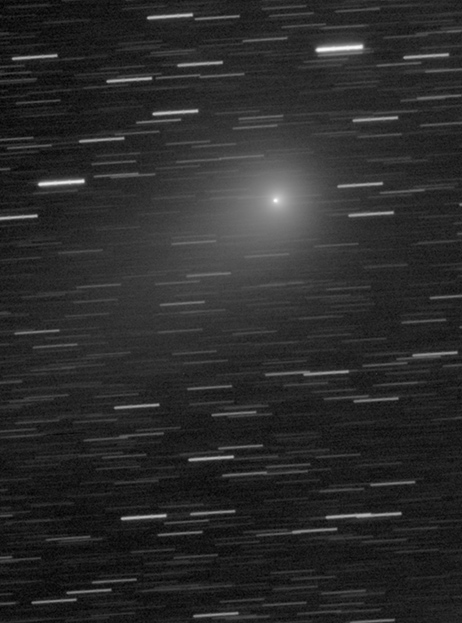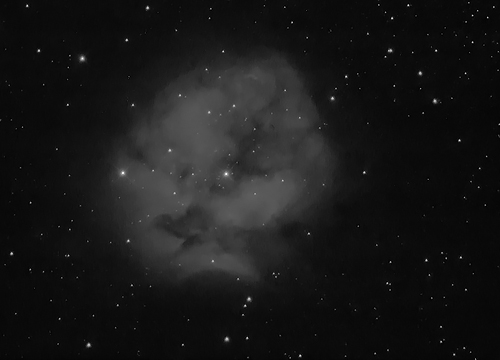9/08/2011. I reassembled the 10-inch hoping I might get a shot of M101's supernova very near its peak brightness. The weather summary suggested that was more likely tomorrow than this evening, but I wanted to be ready. Clouds blew out just after sunset, and I got aligned and focused quickly. The SN is much brighter than the last time I saw it, so much brighter that I didn't recognize the field in the twilight and thought my slew from Arcturus had gone awry. I realigned on Alkaid and tried again, and again landed on this strange field. A longer exposure and a more careful stretch revealed the familiar field stars; the supernova dominated the vew:

August 28, 2011 August 30, 2011 September 8, 2011
I measured the SN's brightness at 11.7 and 11.0 in the first two images above; it's between 9.8 and 9.9 in tonight's. In fact, it saturates my 300s exposures, and the brightness measure comes from a single 60s exposure, the first of the night. I made a dark frame while a cloud blew through, took another couple of L frames, and then lost the sky for a while.
If this one is following the classic luminosity curve of a type Ia supernova, it should be within a day or two of maximum light, and maximum light should be absolute magnitde -19.3. I have combined previous RGB data with tonight's luminance exposures to produce this (noisy) portrait of M101 and its supernova of 2011:

M01 with Supernova near maximum light
300x6, 60x1 L, 300s RGB
If it's at max and its apparent magnitude is 9.9, then the distance modulus to M101 is 9.9 + 19.3 = 29.2 magnitudes. With no allowance for absorption, that puts the galaxy 6.9Mpc or 22.5 million light-years out. That's pretty close to the received wisdom on this one. I made a flat, played with the M101 data, and when I went outside to cover the kit, I found the sky clearing but Moony. I took aim at Comet Garradd, whose celestial coordinates I had looked up and written down against just such an eventuality:

Comet Garradd
60s x 30 L, aligned on the nucleus in Maxim DL
And finally, I moved on to the Cocoon Nebula for H-a until dawn. Subframes are 900s at -25°C. I got three in the can, took a dark frame while showering, and resumed imaging before bed. I hated to throw away the exposure time, but it's too hot during the day to get a dark at that temperature, and it's not trivial to insure total darkness for 15 minutes at a time with the Sun beating down.

IC 5146, The Cocoon Nebula in Cygnus
900s x 16, 7nm Baader H-a
Lots of haze, humidity and an hour-long interval of clouds around 3:30AM... The narrower H-a filter seems to require longer-than-expected subframes. Tonight, 900s was marginal, by which I mean, try longer ones next time. A lusterless sky did not help. Stars are reasonably tight, just over 2.2 arc seconds FWHM.
9/09/2011. Another clear afternoon and cloudy nightfall, but these clouds seemed fixed in place, just below the handle of the Dipper. I made a quick series of one minute frames to get a good photometric fix, then made 300s frames until M101 dipped into the cloudbank. Whether SN 2011fe is brighter by about 0.05 - 0.07 magnitudes or my measurement is simply better I couldn't say, but tonight I put it at 9.82 with reference to Guide 8's data for the two stars on either side. So knock some light-years off the distance. I'll need to dig out a better photometric sequence if I intend to make much of these measurements. A good, sharp run of 300s frames should produce the data for a better portrait; I could combine last night's and tonight's frames for a still-better image. If I can improve on the photo above, I'll show it off below. If not, not.

M101 and SN 2011fe Near Maximum
September 8, 6x300s
September 9, 9x300s
August 28, RGB 1x300s
9/10/2011: Started late with a series of the Ring Nebula of no particular distinction, then slewed to IC 5146, the Cocoon. I added an overnight series to last night's images and got more nebulosity at the expense of bloated stars. Something is off with these efforts.

IC 5146. the Cocoon Nebula in Cygnus
30x900s, 7nm H-a
I begin to think that maybe this fellow is not especially radiant in H-a -- if it were, data collected during seven and a half hours of exposure would not be so tightly jammed up on the left, dim side of the histogram. When the Moon gets out of the way, I'll take L and wideband RGB to try to show the extended envelope and the dark outer regions. Also, it may be that that will require a wider field of view. I could try the focal reducer or take widefield data with the 5-inch. In less Moony times, it will be worth trying the 5D to capture the environs.